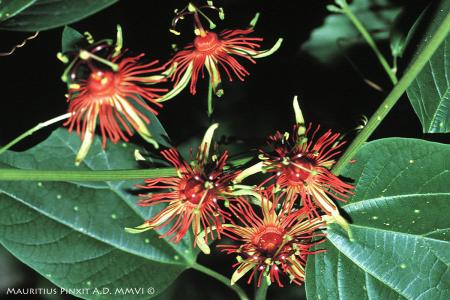
SUBGENUS: decaloba
SUPERSECTION: decaloba
SECTION: decaloba
GEOGRAPHICAL DISTRIBUTION OR ORIGIN:
Mexico
MINIMUM TEMPERATURE: 15 °C
IDEAL MINIMUM TEMPERATURE: 18 °C
SYNONYMS: P. medusae Lemaire, P. trisetosa Roemer.
ETYMOLOGY: Designation of geographical origin as it is native to the Jorullo Mountains (Mexico).
DESCRIPTION:
It is not easy to find cultivated examples of this species as it is not very common among collectors. However, P. jorullensis arrived in Europe in 1983 in the form of its famous hybrid, P. 'Sunburst', a cross between P. gilbertiana and P. jorullensis.
This passionflower's beauty and originality lie both in its leaves and its flowers.
The leaves are bilobate, very large and have an open shape: between the two round-tipped lobes, there is only a slight rounded incision. It is a leaf full of curves, seemingly constructed with a compass, starting from the large semicircle that intersects the petiole's attachment, contrasted by the rounded shape of the lobes and the cleft between them, also in the form of a perfect circle arc.
The dimensions are balanced, approximately 8 cm wide and 8 cm long. Within the leaf blade, supported by 3 main ribs, there are two diverging series of aligned glands, almost parallel to the external ribs.
The flowers have a diameter of only 4 cm yet, despite their small size, arouse curiosity for their shape and the assorted colours that distinguish them.
The corona of filaments is a dominant orange. The light green sepals blend in with the foliage and the petals are so short as to be hardly visible. The corona's halo has a warm sunny colour, more intense in the centre, more nuanced towards yellow at the periphery. The flower is therefore a pale 5-pointed star with the symbol of the sun at its centre.
Flowering in Italy begins in June and continues until September with successive waves. Its fruits are round and shiny, of a beautiful black colour.
P. jorullensis is very demanding in temperature terms, so much so that in winter it already starts to suffer below 15°C, unless these are short, occasional drops. It is therefore advisable to cultivate it in pots (equipped with supports arranged in a perch), and treat it like a botanical rarity, certainly not as a perennial garden plant. It adapts immediately in a pot, and one will see its thin stems, enriched by a velvety tomentosity, grow and thicken with leaves and flowers. Since heat makes it more abundant and lively, in summer, it can be left outdoors in full sun. When autumn arrives, however, it will need a warm, well-lit shelter, such as a small, heated greenhouse, a veranda or a room in the house that gets full light.
It can be cultivated in good multipurpose soil with the addition of a slight percentage of sand to promote drainage.
Propagation is done with cuttings or seeds.